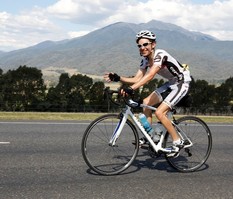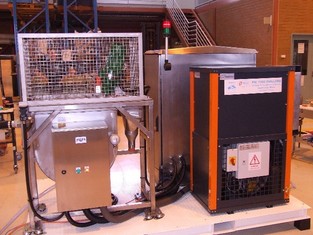A Day in the Life of an X-ray Scientist
Dr Joel O'Dwyer

CURRENT TITLE: Research Scientist
ORGANISATION: CSIRO Mineral Resources
AREA OF EXPERTISE: On-line analysis in minerals processing using XRD, XRF and gamma activation analysis.
YEARS OF EXPERIENCE: 12
EDUCATION: Bachelor of Medical Radiation Physics, PhD (Physics) – University of Wollongong
WEBSITE/TWITTER:
LinkedIn
ORGANISATION: CSIRO Mineral Resources
AREA OF EXPERTISE: On-line analysis in minerals processing using XRD, XRF and gamma activation analysis.
YEARS OF EXPERIENCE: 12
EDUCATION: Bachelor of Medical Radiation Physics, PhD (Physics) – University of Wollongong
WEBSITE/TWITTER:
 CSIRO XRDF on-line ultra-trace elemental and mineralogical analyser.
CSIRO XRDF on-line ultra-trace elemental and mineralogical analyser.
What does your job involve?
I’m part of a CSIRO research group that develops on-line measurement solutions for the minerals processing and mining industries. My job is split into two areas. There’s the management side, where I lead project teams that build XRF and XRD instrumentation for industrial clients. I also engage with industrial clients to explore new applications for our technology. Then there’s the science side where I lead the scientific development of new and improved XRD and XRF measurement systems.
What’s a typical day like?
My days can be quite varied. I spend quite a lot of my time managing project teams, working with our engineers and support staff, and engaging with industry in the process of and building measurement systems for our industrial clients. I also work on improving our XRD and XRF instrumentation, which usually involves running computer simulations using Monte Carlo modelling techniques and a lot of number crunching in Matlab. When I can I like to get my hands dirty in the lab running measurements and playing with X-ray detectors and sources.
What do you love about working with X-rays?
I love the fact that my job is to design and build cool gadgets. It’s like a grown up version of Lego where instead of plastic bricks I use fancy scientific (and sometimes not-so-scientific) equipment. My lab is like an expensive playroom!
What’s challenging?
I find the most challenging aspect of my job is managing the gap between my scientific imagination and engineering reality. As a scientist I like to dream up all kinds of new ways to design and improve our XRD and XRF instruments. Turning those theoretical ideas into reality is a fun and sometimes very challenging process.
Any advice to people looking for a career in X-ray analysis?
A degree in science or engineering will enable a graduate to work in an X-ray related field. Today there are a number of universities offering degrees more specifically related to radiation and X-ray physics, such as Medical Physics. This is an excellent way to start a career in X-rays.
Why is it good to be involved with AXAA?
AXAA’s triennial conference “AXAA Workshops, Conference and Exhibition” is one of the best conference series I’ve had the pleasure of attending – even better than some of the larger conferences in North America and Europe. AXAA is also a great resource for learning about the latest developments in the world of X-rays, as well as making new connections and collaborations.
I’m part of a CSIRO research group that develops on-line measurement solutions for the minerals processing and mining industries. My job is split into two areas. There’s the management side, where I lead project teams that build XRF and XRD instrumentation for industrial clients. I also engage with industrial clients to explore new applications for our technology. Then there’s the science side where I lead the scientific development of new and improved XRD and XRF measurement systems.
What’s a typical day like?
My days can be quite varied. I spend quite a lot of my time managing project teams, working with our engineers and support staff, and engaging with industry in the process of and building measurement systems for our industrial clients. I also work on improving our XRD and XRF instrumentation, which usually involves running computer simulations using Monte Carlo modelling techniques and a lot of number crunching in Matlab. When I can I like to get my hands dirty in the lab running measurements and playing with X-ray detectors and sources.
What do you love about working with X-rays?
I love the fact that my job is to design and build cool gadgets. It’s like a grown up version of Lego where instead of plastic bricks I use fancy scientific (and sometimes not-so-scientific) equipment. My lab is like an expensive playroom!
What’s challenging?
I find the most challenging aspect of my job is managing the gap between my scientific imagination and engineering reality. As a scientist I like to dream up all kinds of new ways to design and improve our XRD and XRF instruments. Turning those theoretical ideas into reality is a fun and sometimes very challenging process.
Any advice to people looking for a career in X-ray analysis?
A degree in science or engineering will enable a graduate to work in an X-ray related field. Today there are a number of universities offering degrees more specifically related to radiation and X-ray physics, such as Medical Physics. This is an excellent way to start a career in X-rays.
Why is it good to be involved with AXAA?
AXAA’s triennial conference “AXAA Workshops, Conference and Exhibition” is one of the best conference series I’ve had the pleasure of attending – even better than some of the larger conferences in North America and Europe. AXAA is also a great resource for learning about the latest developments in the world of X-rays, as well as making new connections and collaborations.
